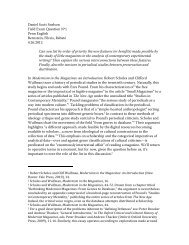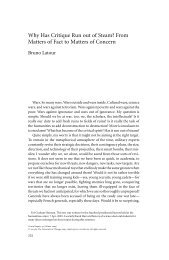The Exploit: A Theory of Networks - asounder
The Exploit: A Theory of Networks - asounder
The Exploit: A Theory of Networks - asounder
Create successful ePaper yourself
Turn your PDF publications into a flip-book with our unique Google optimized e-Paper software.
122 Edges<br />
data may soon be required in advance from both infected and non -<br />
infected organisms. (We are already witnessing this in the areas <strong>of</strong><br />
genetic screening, genetic counseling, and DNA fingerprinting.)<br />
Imagine a computer simulation like the popular game SimCity in<br />
which the player develops, builds, and manages a city. But imagine<br />
that instead <strong>of</strong> managing a whole city, the goal is to manage the medi -<br />
cal health <strong>of</strong> the city’s inhabitants; instead <strong>of</strong> being the mayor <strong>of</strong><br />
SimCity, the player is an <strong>of</strong>ficial CDC virus hunter. <strong>The</strong> goal <strong>of</strong> the<br />
game is to watch for potential disease outbreaks and also manage the<br />
health <strong>of</strong> the population on a regular basis (including hospital funding,<br />
emergency services, and research centers). This would help illustrate<br />
the future <strong>of</strong> the network model <strong>of</strong> public health, itself already<br />
fully digitized, online, and multiplayer.<br />
In the informatic mode, disease is always virtual. It creates a virtual<br />
state <strong>of</strong> permanent emergency wherein infection is always kept just out<br />
<strong>of</strong> reach. And the state <strong>of</strong> permanent emergency can only be propped<br />
up by means <strong>of</strong> better and better medical surveillance systems.<br />
Feedback versus Interaction I<br />
In the twentieth century there came to pass an evolution in the nature<br />
<strong>of</strong> two - way communication within mass media. This evolution is typified<br />
by two models: feedback and interaction. <strong>The</strong> first model consists<br />
<strong>of</strong> what Beniger calls the mass feedback technologies:<br />
Market research (the idea first appeared as “commercial research” in<br />
1911), including questionnaire surveys <strong>of</strong> magazine readership, the<br />
Audit Bureau <strong>of</strong> Circulation (1914), house - to - house interviewing<br />
(1916), attitudinal and opinion surveys (a U.S. bibliography lists<br />
nearly three thousand by 1928), a Census <strong>of</strong> Distribution (1929),<br />
large - scale statistical sampling theory (1930), indices <strong>of</strong> retail sales<br />
(1933), A. C. Nielsen’s audimeter monitoring <strong>of</strong> broadcast audiences<br />
(1935), and statistical - sample surveys like the Gallup Poll (1936). 24<br />
<strong>The</strong>se technologies establish two - way communications; however, like<br />
the media they hope to analyze, the communication loop here is not<br />
symmetrical. Information flows in one direction, from the viewing<br />
public to the institutions <strong>of</strong> monitoring.<br />
Contrast this with the entirely different technique <strong>of</strong> two - way communication<br />
called interaction. As a technology, interaction does not









